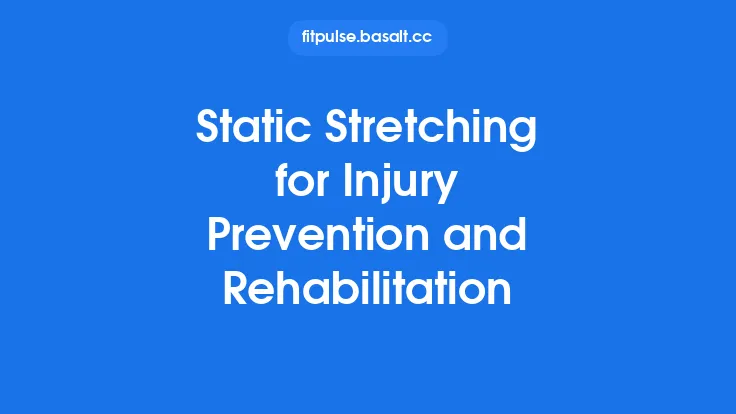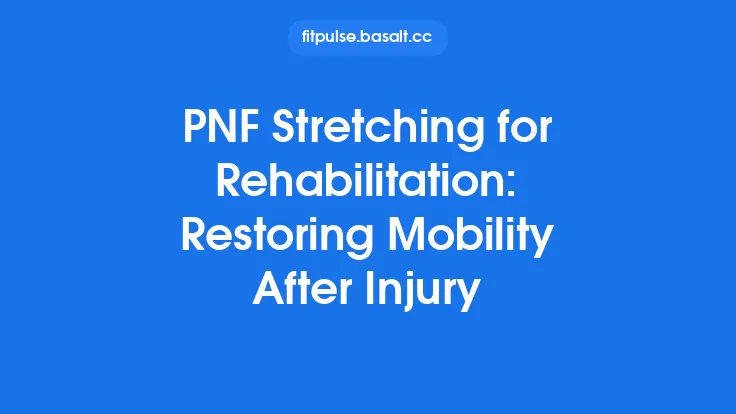Active Isolated Stretching (AIS) has become a popular tool not only for athletes seeking greater range of motion but also for clinicians and individuals aiming to protect their bodies from injury and to aid the recovery process after tissue damage. While many resources focus on the mechanics of the technique or how to weave it into a performance‑oriented warm‑up, this article explores the broader, evergreen role of AIS in injury prevention and rehabilitation. By understanding the underlying concepts, the physiological responses it elicits, and the practical considerations for its safe use, practitioners can incorporate AIS as a complementary strategy within a comprehensive health‑maintenance plan.
Why Flexibility Matters in Injury Prevention
A joint’s ability to move through its full, functional range is a cornerstone of musculoskeletal health. When a muscle or connective tissue is chronically shortened, several adverse outcomes can arise:
- Altered Kinematics – Limited motion forces adjacent joints to compensate, creating abnormal movement patterns that increase stress on ligaments, tendons, and cartilage.
- Reduced Shock Absorption – Muscles that cannot lengthen adequately fail to dissipate forces efficiently, transmitting higher impact loads to bone and joint structures.
- Impaired Neuromuscular Control – Tight musculature can inhibit proprioceptive feedback, diminishing the body’s ability to make rapid, precise adjustments during dynamic activities.
Collectively, these factors raise the likelihood of strains, sprains, overuse syndromes, and even acute traumatic injuries. Maintaining or restoring optimal flexibility therefore serves as a proactive defense, allowing tissues to operate within their designed limits and preserving the integrity of movement chains.
Core Principles of Active Isolated Stretching Relevant to Rehab
Although AIS is often described in step‑by‑step manuals, its therapeutic value stems from a handful of foundational ideas that align well with rehabilitation goals:
- Brief, Repeated Holds – AIS employs 2‑ to 5‑second stretches repeated several times per muscle group. This short‑duration approach minimizes the risk of triggering the stretch reflex, which can cause a sudden contraction and potentially exacerbate an injury.
- Active Contraction of the Opposing Muscle – By engaging the antagonist, the practitioner creates a gentle, controlled pull that encourages the target muscle to relax without forcing it beyond its current tolerance.
- Progressive Overload Through Repetition, Not Intensity – Flexibility gains are achieved by increasing the number of repetitions rather than the force applied, a principle that dovetails with the gradual loading strategies used in tissue healing.
- Use of Light External Assistance – When a therapist or partner provides a modest amount of assistance, the stretch remains within a safe, pain‑free zone, allowing the injured tissue to be mobilized without overstressing it.
These concepts make AIS particularly suitable for early‑stage rehab, where the priority is to restore motion without compromising the healing process.
How AIS Supports Tissue Healing
The biological environment of an injured muscle, tendon, or ligament is characterized by inflammation, collagen remodeling, and gradual restoration of tensile strength. AIS can positively influence several of these phases:
- Modulation of Inflammatory Mediators – Gentle, rhythmic movement has been shown to promote circulation, which helps clear metabolic waste and deliver nutrients essential for repair. AIS’s low‑intensity nature avoids the excessive mechanical stress that could reignite inflammation.
- Collagen Alignment – Controlled, repeated stretching encourages newly synthesized collagen fibers to align along the direction of functional stress. Over time, this contributes to stronger, more resilient tissue that mirrors the original architecture.
- Neurophysiological Reset – By repeatedly stimulating the muscle spindle and Golgi tendon organ in a non‑painful manner, AIS can recalibrate the central nervous system’s perception of stretch tolerance, reducing protective guarding that often lingers after injury.
- Maintenance of Joint Lubrication – The brief, dynamic motion promotes synovial fluid distribution, supporting cartilage health and joint nutrition—critical considerations when immobilization has been part of the treatment plan.
These mechanisms collectively accelerate the transition from the inflammatory to the proliferative stage of healing, while also safeguarding against the formation of restrictive scar tissue.
Applying AIS in Different Stages of Rehabilitation
1. Acute Phase (0‑7 Days Post‑Injury)
- Goal: Preserve a minimal functional range and prevent adhesions.
- Approach: Perform AIS within a pain‑free window (typically 0‑10% of the maximal stretch intensity). Use a therapist’s hand to provide just enough assistance to achieve a gentle stretch, limiting each hold to 2 seconds and repeating 3‑5 times per muscle group.
- Precautions: Avoid aggressive stretching of inflamed tissues; prioritize edema control and pain management.
2. Sub‑Acute Phase (1‑3 Weeks)
- Goal: Gradually increase range of motion while supporting tissue remodeling.
- Approach: Extend hold duration to 3‑4 seconds and increase repetitions to 6‑8 per set. Introduce light active contractions of the antagonist to enhance the stretch without overloading the healing structure.
- Precautions: Monitor for any resurgence of pain or swelling; adjust intensity accordingly.
3. Remodeling Phase (3‑6 Weeks)
- Goal: Restore functional flexibility and integrate movement patterns required for daily activities or sport‑specific tasks.
- Approach: Combine AIS with functional movement drills. Hold times can be increased to 5 seconds, and repetitions may rise to 10‑12 per muscle group. Begin to incorporate dynamic AIS sequences that transition smoothly into the next joint or muscle group.
- Precautions: Ensure that the increased volume does not compromise the integrity of the repaired tissue; maintain a balance with strengthening work.
4. Return‑to‑Activity Phase (6+ Weeks)
- Goal: Achieve pre‑injury flexibility levels and reinforce neuromuscular control.
- Approach: Use AIS as a maintenance tool, performing 2‑3 sessions per week. Integrate AIS into sport‑specific warm‑ups or cool‑downs to preserve the gains achieved during rehab.
- Precautions: Continue to respect individual tissue tolerance; avoid complacency that could lead to over‑stretching.
Guidelines for Safe Implementation
- Pain as a Guide: Stretch only to a point of mild tension; any sharp or lingering pain signals that the tissue is not ready for further load.
- Controlled Breathing: Encourage diaphragmatic breathing throughout each hold; exhalation can facilitate a subtle relaxation response, enhancing stretch effectiveness.
- Consistent Positioning: Keep the joint angle consistent across repetitions to ensure that the stretch targets the same tissue fibers each time.
- Partner Communication: When assistance is provided, maintain open dialogue about pressure levels and comfort, allowing immediate adjustments.
- Documentation: Even though detailed program metrics are beyond the scope of this article, a simple log of session date, muscle group, hold duration, and perceived effort can help track progress and identify any setbacks early.
Collaborating with Healthcare Professionals
Integrating AIS into a broader rehabilitation plan works best when there is clear communication between the practitioner delivering the stretch and the primary healthcare provider (physiotherapist, sports medicine physician, or orthopedic specialist). Key collaborative steps include:
- Initial Assessment Review – Obtain the diagnosis, tissue healing timeline, and any contraindications (e.g., acute fractures, severe tendon ruptures).
- Goal Alignment – Ensure that the flexibility objectives complement strength, proprioception, and functional milestones set by the rehab team.
- Feedback Loop – Share observations about tissue response, pain levels, and range improvements after each AIS session, allowing the clinician to adjust the overall treatment plan as needed.
- Education – Teach the patient or athlete how to perform AIS safely on their own, reinforcing the therapist’s instructions and fostering self‑management.
Illustrative Case Scenarios
Case 1: Hamstring Strain in a Recreational Runner
- Injury Profile: Grade II midsubstance strain, 10 days post‑injury, mild swelling, limited knee flexion to 80°.
- AIS Application: Therapist performed AIS on the hamstring with 3‑second holds, 5 repetitions, using light manual assistance while the patient actively contracted the quadriceps. After two weeks, knee flexion improved to 110°, and the runner reported reduced tightness during easy jogs.
- Outcome: The gradual increase in AIS volume, combined with progressive strengthening, facilitated a return to full training at week six without recurrence.
Case 2: Post‑Operative Shoulder Rehabilitation
- Injury Profile: Arthroscopic rotator cuff repair, immobilized in a sling for three weeks.
- AIS Application: Starting at week four, AIS was introduced for the posterior deltoid and upper trapezius with 2‑second holds, 4 repetitions, performed by the physical therapist. The stretch was performed within a pain‑free range, avoiding stress on the repaired tendons.
- Outcome: By week eight, passive external rotation increased by 15°, and the patient progressed to active-assisted range of motion exercises, ultimately achieving full functional use by month four.
Case 3: Chronic Low‑Back Pain with Tight Hip Flexors
- Injury Profile: Persistent lumbar discomfort linked to anterior pelvic tilt and shortened iliopsoas.
- AIS Application: Weekly AIS sessions targeted the hip flexors with 4‑second holds, 8 repetitions, while the client performed gentle diaphragmatic breathing. Over six weeks, the client reported a noticeable reduction in low‑back tension and improved lumbar extension during daily activities.
- Outcome: The combination of AIS and core stabilization exercises resulted in a sustainable improvement in posture and pain levels.
Potential Limitations and When to Seek Alternative Approaches
While AIS offers many benefits, it is not a universal remedy. Situations where AIS may be less appropriate include:
- Severe Acute Injuries – In cases of complete tears, fractures, or high‑grade ligament sprains, any stretch may jeopardize the healing tissue. Immobilization and controlled passive range of motion under professional supervision are preferred initially.
- Neurological Conditions – Patients with significant proprioceptive deficits or spasticity may require specialized neuro‑rehabilitation techniques before AIS can be safely introduced.
- Joint Instability – If a joint lacks sufficient static stability, aggressive stretching—even brief—could exacerbate laxity. Stabilization exercises should precede flexibility work.
In these contexts, clinicians should prioritize evidence‑based modalities tailored to the specific pathology, reserving AIS for later stages when the tissue has attained adequate resilience.
Key Takeaways
- Flexibility is a preventive shield; maintaining functional range reduces compensatory stresses that often precipitate injury.
- AIS’s hallmark—short, repeated, active stretches—aligns with the incremental loading philosophy central to safe tissue healing.
- Physiological benefits include improved circulation, favorable collagen alignment, neuro‑muscular recalibration, and enhanced joint lubrication.
- Stage‑specific application ensures that the stretch intensity matches the tissue’s healing capacity, from acute to return‑to‑activity phases.
- Safety hinges on pain monitoring, controlled breathing, consistent positioning, and clear communication between therapist and patient.
- Collaboration with healthcare professionals maximizes the integration of AIS within a holistic rehabilitation program, fostering better outcomes.
- Awareness of limitations prevents misuse and directs individuals toward more suitable interventions when necessary.
By respecting these principles, practitioners can harness Active Isolated Stretching as a reliable, evidence‑informed component of injury prevention and rehabilitation strategies—helping bodies move more freely, recover more efficiently, and stay healthier over the long term.





